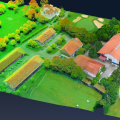
An Australian company has developed a laser tracking system that will help stop chunks of space debris colliding with spacecraft and satellites in the Earth's orbit.
The laser tracking system has previously been used to track satellites, but Electric Optic Systems said it could now locate and track debris as small as 10 centimetres across, protecting astronauts and satellites.
Around 200,000 objects measuring less than one centimetre are currently floating in Earth’s orbit, with another 500,000 of a centimetre or larger.
Craig Smith, the company's CEO, said current space surveillance and tracking systems cannot determine orbits in space with sufficient accuracy to prevent collisions.
“These new features, to be demonstrated from 2012, can significantly reduce the cost of providing debris protection to satellites, and will ease the integration of the capability into the operational processes of key users,” he said. "What it does allow is for us to track the orbits very accurately, and if we have accurate orbit determination then you can determine whether you're going to run into space debris."
Tiny objects, left behind by disused rockets and satellites, can devastate hardware because they are travelling at ultra-high speeds.
Electric Optic Systems has received a $4m federal grant from the Australian government to develop the technology.
Junk will be tracked from the Mount Stromlo observatory in Canberra and the data sold to satellite owners and bodies like NASA.
Those using the data will then be able to use it to move satellites or astronauts to safety.
In the future the firm hopes to develop a network of tracking stations placed at strategic points around the globe.







